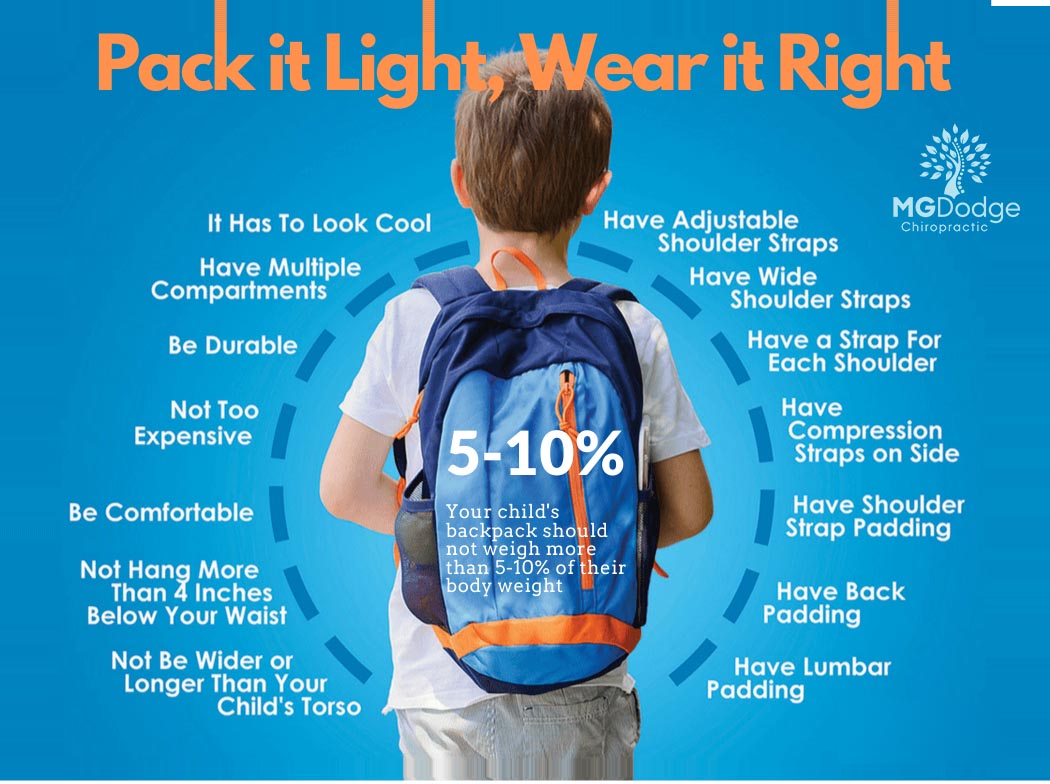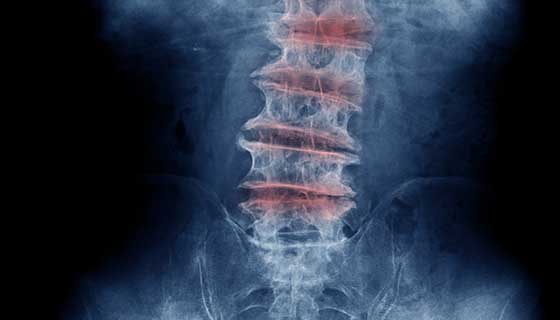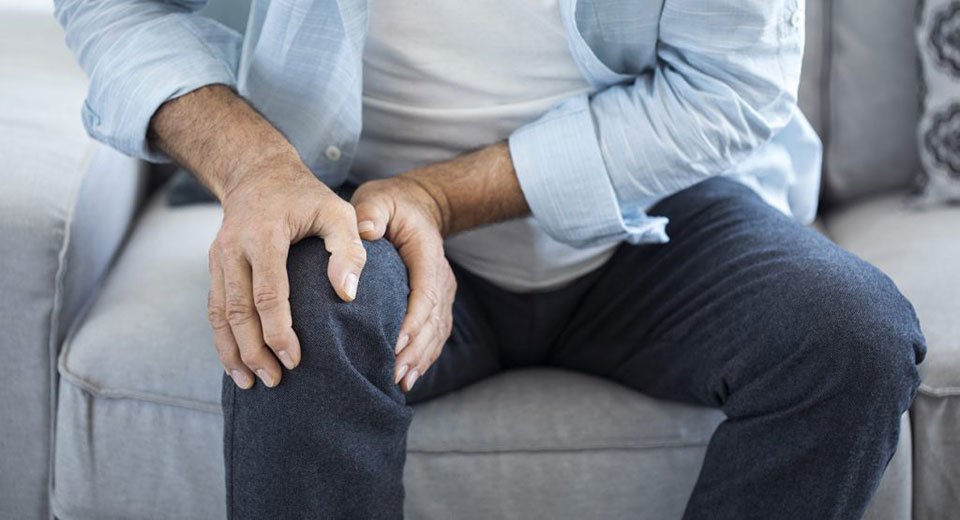 26 Aug 2022
26 Aug 2022
Your Kid’s Backpacks
Tips for back-to-school spinal health for your kids
School is back in session for 2022. Not only does this mean another year of knowledge, it also means another year of students lugging around heavy backpacks day after day. Couple this with the stress of striving for success and you’ve got a recipe for chronic aches and back pains at a young age.
Carrying backpacks loaded with heavy textbooks, binders, and folders can inhibit the back’s natural development. Combined with posture challenges like sitting all day in class and hunching over a computer doing homework, your child might need some support—especially in these formative years. That’s where chiropractic comes in.
Chiropractic is a safe way for students of all ages to address some of the cumulative problems their posture might be subjected to each school day. It could be instrumental in combating back conditions that might otherwise follow your child through life.
1. Lift properly
Just like any other lifting, it’s important to be mindful of posture when picking up a backpack. Instead of reaching over and awkwardly curving the spine, use the legs to create leverage when lifting. Show your child how to put the pack behind themselves, put the arms through the straps, then use their legs to stand. Avoid slinging it quickly around the shoulders.
2. Use both straps
Many kids think it’s cool to use a single strap when carrying their backpacks. Unfortunately, while this might look cool, it’s a quick way to create unnecessary stress on the shoulders, neck, and spine. Wearing both backpack straps means the weight is more evenly distributed and ensures that additional stress isn’t placed on the spine. It may not look the coolest, but it’s better than chronic pain!
3. Keep the backpack light
While it’s important to take necessary school items, make sure your child limits other items in the backpack. They may also be able to take textbooks to class on alternate days or leave them at school when they don’t have homework. The aim of the game is to lighten the load, to make it more manageable on the spine.
4. Tighten the straps
If the backpack is hanging low, the straps aren’t tight enough. Make sure straps are secure on the shoulders and fit with the spine to create proper support. Loose-hanging backpacks cause gravity to work against the spine, which means exerting more effort to keep the pack in place.
5. Limit time wearing the backpack
Let’s face it: kids don’t often think ahead. Instead of thinking about which book they need for their next class, their minds are elsewhere. For most kids, the simplest solution is to carry everything, all the time. As you can imagine, this is unhealthy for the spine and not good for posture. Instead, encourage your child to use their locker or cubbie, so they don’t have to carry that heavy backpack all day long.
If your kid is experiencing back, neck, or shoulder pain, MGDodge Chiropractic is here to help. We’ve seen the damage that students suffer when their backpacks are filled to the brim. Contact us today to learn more about how to limit the stress on your kid’s spine.
Uncategorized
COMMENTS: No Comments
 08 Apr 2022
08 Apr 2022
SPORTS
ATV riding and spinal health
There has been a startling increase in injuries and mortalities from the use of ATVs. Not only is it because ATVs have become more for recreational fun, but it also is attributed to the production of larger, faster, and more powerful ATVs. Commonly, people who use or even own an ATV do not realize how powerful and dangerous these vehicles can be – even if you know how to safely operate one.
Chiropractic Care can Help ATV Injuries
Most ATV-related injuries include: deep, soft-tissue trauma and fractures/dislocations. Other injuries related to ATV accidents include:
- Headaches
- Nausea
- Dizziness
- Fatigue
- Lack of sleep
- Trouble breathing
- Soreness/tension in various regions of the body
- Sprains/Fractures
- Low back injuries
- Neck injuries
- TMJ problems
- Reduced range of motion
- And many more…
Trying to “just deal with” the pain can lead to more complications in the future. It is important to seek treatment even if you do not feel like your symptoms and injuries are bad.
What does this have to do with Chiropractic?
Chiropractic care is a safe and effective way of treating patients who have suffered from an ATV accident. Chiropractic care uses a hands-on, drug-free approach to helping people, which includes examination, diagnosis, and treatment. Chiropractic care focuses on treating the entire body, not just a “quick fix”.
At MG Dodge Chiropractic, we are an easy commute for people in Lewis County, Carthage, Watertown, Booneville, Turin and Fort Drum. We use rehabilitative and therapeutic therapies, as well as spinal adjustments to get your overall health and well-being back.
Knowing how to stay safe will help prevent future injuries on your ATV. Be sure to include chiropractic care in your prevention program. Regular chiropractic care can help ward off vertebral subluxations and related disorders.
Uncategorized
COMMENTS: No Comments
 08 Apr 2022
08 Apr 2022
Imaging
Does my Chiropractor need x-rays of my Spine?
In order for a chiropractor to better diagnose your condition, they will need to take a look at what’s going on underneath the surface. X-rays are one of the most widely used diagnostic tools in chiropractic care. Seeing what is happening more closely will allow your chiropractor to better understand your situation, making it possible for them to come up with a more accurate diagnosis and a treatment plan that will be specifically catered to your condition. If you still aren’t convinced that chiropractors need x-rays, keep reading! This article may prove otherwise.
Chiropractic processes
If it’s your first time getting chiropractic care, you need to know that the biggest element of chiropractic care is diagnostic testing. Chiropractors will use multiple techniques in order to best understand what is going on so that they can identify the source of your pain. X-rays are the diagnostic tools most widely used because they allow the chiropractor to see more deeply into your body and internal layout.
X-rays can be invaluable tools dor diagnosis
Chiropractors will use x-rays as a way to get a better idea of a patient’s condition or injury. Through an x-ray, your doctor will be able to pinpoint the exact place that might be having issues and where your pain emanates. They will be looking for any spinal misalignment and any other related injuries in order to diagnose your condition accurately. By knowing exactly what is wrong, your chiropractor will also be able to determine what is needed for treatment.
They will be able to decide the frequency and intensity of care needed for a full recovery. Knowing about or finding any other spinal issues that you might have not been aware of can also help you improve your overall health since they will be able to treat that as well. It is important to diagnose and treat these symptoms as soon as possible because it may just fix whatever else might be wrong with your body. A lot of the time, simply realigning your spine can make a huge difference in the way that you feel.
What we’re looking for in imaging
An x-ray of your spine can give a Chiropractor a clearer view of your spinal health, especially after a car accident. Any abnormalities will be spotted. Your chiropractor will be able to make adjustments and provide treatment to any preceding issues that might have gone untreated. The spine is the most important part of your body, and an x-ray will allow the doctor to see if there are any complications that need to be fixed before any treatment is carried out for your main issue.
X-rays can also help Dr. Dodge find any bone spurs, cancerous spots, or fractures that can worsen in time or with adjustments. An x-ray may also allow the doctor to see any important characteristics that might be unique to you, such as bone spacing and density. These diagnostic tools also help chiropractors during treatment.
They can be a great visual representation of progress made from treatment. Being able to re-examine the alignment and motion of the spine is all part of the treatment process, and x-rays will help by being physical proof that all is working as it should be. They will also be great for before and after pictures to show treatment progress.
If you feel an X-ray might help Dr. Dodge diagnose and treat your pain better, you’re in luck! M.G. Dodge Chiropractic has a state-of-the-art x-ray unit at our office in Alton. Be sure to mention you read this article when you stop by for your next appointment and Dr. Dodge would be happy to show it to you.
Uncategorized
COMMENTS: No Comments
 08 Apr 2022
08 Apr 2022
Chiropractic and pregnancy
Everyones first question: is it safe?
Chiropractic care is the health maintenance of the spinal column and the adjustment of misaligned joints. It doesn’t involve drugs or surgery. Instead, it’s a kind of physical therapy to reduce spinal nerve stress and promote health throughout the body.
More than 1 million chiropractic adjustments are given every day, all over the world. Complications are rare. During pregnancy, chiropractic care is believed to be safe. But there are certain circumstances where chiropractic care may not be a good idea.
Always get your doctor’s approval before seeing a chiropractor during pregnancy. Chiropractic care isn’t typically recommended if you’re experiencing the following:
- vaginal bleeding
- placenta previa or placenta abruption
- ectopic pregnancy
- moderate to severe toxemia
While all licensed chiropractors receive training related to pregnancy, some chiropractors specialize in prenatal care. Ask if they specialize in this area, or get a referral from your doctor.
To adjust pregnant women, chiropractors will use adjusting tables to accommodate their growing bellies. All chiropractors should use techniques that won’t put pressure on the abdomen.
Chiropractors can also show you effective stretches for relieving tension and easing discomfort.
How can chiropractic care help during pregnancy?
There are many hormonal and physical changes you’ll experience during your pregnancy. Some of these will have an impact on your posture and comfort. As your baby becomes heavier, your center of gravity shifts, and your posture adjusts accordingly.
These physical changes during your pregnancy can lead to a misaligned spine or joints.
Other uncomfortable changes during pregnancy might include:
- a protruding abdomen resulting in an increased curve of your back
- changes to your pelvis as your body begins to prepare for labor
- adaptations to your posture
Regular visits to a chiropractor during your pregnancy can address these issues. One collaborative chiropractic and medical study revealed that 75 percent of pregnant chiropractic care patients reported pain relief. Plus, adjustments designed to re-establish balance and alignment to your pelvis and spine will do more than just make you feel better. Chiropractic care can be beneficial for your baby, too.
 Dr. Kristin Bezek of our Sodus Office is uniquely trained in prenatal chiropractic care. If you have any questions or concerns about this issue, feel free to call our office and talk directly with her at (315) 498 0243, or stop by at 8479 Ridge Rd., we’re happy to help answer any questions you might have.
Dr. Kristin Bezek of our Sodus Office is uniquely trained in prenatal chiropractic care. If you have any questions or concerns about this issue, feel free to call our office and talk directly with her at (315) 498 0243, or stop by at 8479 Ridge Rd., we’re happy to help answer any questions you might have.
Excerpted from “Chiropractic while pregnant” originally written for HEALTHLINE.com. Read the full article here.
Uncategorized
COMMENTS: No Comments
 20 Oct 2021
20 Oct 2021
Beat the Cold-weather blues. Tips for dealing with winter stiffness
Many who suffer from chronic joint stiffness and pain find that cold winter weather worsens their symptoms. Though the scientific evidence behind this relationship is inconclusive, taking a few extra measures to ease joint pain may help you brave the snow, rain, and low temperatures that are a staple of Buffalo winters.
These tips are meant to be as inclusive as possible and should help mitigate arthritis flare-ups, as well as fight stiff and painful joints for the majority of people out there. However, each person’s experience with arthritis is different, and it is important to find out what works best for you.
It is also important to note that while these tips will help you fight joint stiffness and pain during the cold months, they are by no means a cure. If you have arthritis, it is important to visit an orthopaedic specialist to receive a proper diagnosis and potential treatment options.
Staying Warm
Though not all arthritis patients agree on this, many patients find that warm weather makes their condition more manageable. Unfortunately, we are not all blessed with the opportunity to live in a warm climate.
Everyone puts on extra layers in wintertime but if you suffer from arthritis staying warm becomes even more important. Here are a few ways to keep the effects of cold weather at bay.
1. Wear Light but Warm Layers
Wearing several layers of clothing is the best way to trap warm air close to your body. However, wearing bulky and heavy clothing won’t do you any favours if you already feel stiff.
Be smart in your choice of clothing materials – stick to breathable cotton as your first layer and then add on lightweight wool or fleece. Make sure that your outerwear is suitable for the weather and does not let in any moisture.
Your core, from your hips up to your shoulders, is the most important part of your body to keep warm. This promotes a better blood flow which in turn also keeps your entire body warmer.
2. Wear Compression Socks and Gloves
Your extremities are the first parts of your body to cool down. These areas also have poorer blood circulation, especially in women.
Compression socks and gloves help with both your blood circulation and trapping heat so they are a worthy purchase. You might also want to add compression tights or thermal tights to your wardrobe.
3. Take a Hot Bath or Shower
A hot bath is not only relaxing but can also serve as great pain relief. A hot bath improves your blood flow and relaxes muscles, which can reduce your arthritis-related pain.
Make sure that you don’t cool off too quickly after steaming in the bathroom. Step into warm and comfortable clothing directly afterwards.
4. Sleep with Extra Warmth
Although it is often said that sleeping at cooler temperatures gives you a better night’s sleep, this won’t be the case if you are already experiencing joint pain from the cold. During the winter, staying warm during the night can help keep joint stiffness and pain at bay when you wake up.
Staying Active
Although it is often easier said than done, staying active is an integral part in preventing joint stiffness. If the outdoors does not seem inviting during cold weather, staying active indoors is a great alternative.
1. Daytime Outdoor Activities
Vitamin D has been shown to help improve bone health, as well as give your immune system a much-needed boost. Since the sun is the best source of vitamin D, getting your necessary dose becomes more difficult during the winter.
Going for a walk or partaking in other light outdoor activities can help you soak up the few rays that do peek through during winter (remember to bundle up!). Walking your dog, finding an exercise buddy, and opting to walk instead of taking the car on short trips are all great ways to get outdoors.
2. Take Classes
If you are not the type to get excited about going to the gym, signing yourself up for exercise classes gives you an extra push to stay consistent. Find a sport that suits your condition though, do not join a class that would only make you feel worse.
Indoor classes are a good alternative to outdoor activities. They are rarely affected by the weather and being indoors also keeps you warm.
3. Get a Massage
Though this is not technically staying active, it can help with pain management, especially when done regularly. A good massage therapist will know how to relieve your joints and relax your muscles, it also helps with blood flow.
Adjust Your Diet and Supplements
If you know that colder weather affects you negatively, start paying closer attention to your diet and supplements before the temperature drops. Preparing your body from the inside out can help minimize the impact of cold weather.
1. Consume Vitamin D
As mentioned, vitamin D is very important for those suffering from arthritis. Since there are fewer sun hours during winter, you may consider taking vitamin D supplements (but always after consulting with your primary care doctor).
There are also foods rich in vitamin D that you can make part of your staple winter diet. Examples are fatty fish like salmon and sardines, mushrooms, milk, shrimp, egg yolks and cod liver oil.
2. Consult Your Chiropractor
Although many try to treat their arthritis through lifestyle changes instead of medication, sometimes you need more targeted treatment. Advanced stages of arthritis can be extremely impactful on your everyday life, and no amount of keeping warm will relieve your pain and stiffness. In these cases, chiropractic specialists like Dr Michelle Dodge, Dr Kristen Bezek, or Dr Ashley Lapinski at MG Dodge Chiropractic can help diagnose and treat your symptoms, and get you back to the pain-free life you deserve.
If you are tired of suffering from joint stiffness and pain, give us a call or schedule an appointment with one of our office today.
Uncategorized
COMMENTS: No Comments
 18 Sep 2021
18 Sep 2021
7 Epsom Salt Facts to Learn
Things you may not already know about Epsolm Salt
#1- It’s nothing like table salt. Epsom salt was named for a bitter saline spring at Epsom in Surrey, England. It is one of many naturally occurring mineral salts, a compound of magnesium and sulfate.
#2- Epsom salt is good for the mind. Epsom salt helps stabilize mood and relieve stress, anxiety and depression. In fact, some researchers claim that taking magnesium increases serotonin (happiness or relaxation hormone) production in the brain.
#3- Epsom salt is good for the body. Epsom salt helps relax muscles and relieve pain in the shoulders, neck, back and skull. For example, by relaxing the muscles surrounding the skull, the magnesium in Epsom salt may help release a headache or migraine.
Some researchers also think that magnesium is good for reducing inflammation in internal organs. This may help reduce the risk of cardiovascular disease and improve digestion/bowel movement. Integrative medical experts commonly recommend Epsom salt to patients with chronic fatigue syndrome and cold intolerance.
What about Epsom salt’s ability to correct a magnesium deficiency? While doctors expect better magnesium absorption through the skin, there’s no published research that compares oral magnesium supplementation with magnesium absorption through the skin.
#4- It only takes 15 minutes to benefit. Put 300 grams of Epsom salt into a bathtub filled with hot water. In just 15 minutes, you will start to experience the mental and physical benefits of Epsom salt.
#5- Epsom salt is for external use only. Some may claim that drinking Epsom salt is good for detoxification. The truth is that drinking Epsom salt causes some people to experience serious side effects such as severe diarrhea. Sudden and dramatic changes in bowel behavior can be very dangerous and cause dehydration and discomfort. There are no studies to prove that taking Epsom salt orally is safe or beneficial.
#6- It’s bad for people with severe skin inflammation or infection. No one with an open wound or a severe burn should use Epsom salt. If you have an open wound, consult your dermatologist before use.
#7- Buy Epsom salt from a reputable source. Healthy supermarkets (e.g., Whole Foods Market or Fresh Thyme Farmer’s Market) typically offer the best quality Epsom salt. Be sure to buy 100 percent magnesium sulfate. Beware of online retailers who may offer exceptional deals but cannot guarantee quality or purity.
Uncategorized
COMMENTS: No Comments
 24 Aug 2021
24 Aug 2021
Working out for better brains!
| More Exercises Are Proving Helpful for Optimal Brain Health & Function | |
| How can you boost brainpower? It’s an important question to ask, especially with the rise of dementia and Alzheimer’s diseases. Is there really anything that can be done to achieve optimal brain health in an effort to ward off these debilitating diseases? Indeed there is! Reuters recently reported on a study that found more and more physical exercises are proving useful for brain health. Tai Chi seems to dominate the cognitive function category. But they’re definitely not alone – which is great news for people who like activities that are more energetic. A variety of strength training and aerobic exercises have been shown to slow cognitive decline in adults over the age of 50. Neurons in the brain fire whenever people are engaged in a form of physical activity. Even something like walking regularly can have a profound effect on brain function. The neurons in the brain fire whenever people have to balance and contract their muscles. Not only does the rapid firing help the body to perform these functions even better, they keep the brain active and healthy. The Harvard Health Blog recommends walking at the very least. If people aren’t into that, they can try: Swimming Dancing Tennis Aerobics Classes and even hiring a personal trainer. The goal here is not so much what type of physical activity a person engages in, but the regularity in which they do it. Exercising at least three days a week is a good start for achieving optimal brain health. Another good thing is a regular visit to your local chiropractor to keep joints and tissues healthy and strong. Visit your friends at MG Dodge chiropractic today and align yourself with good health, for your body and your brain! |
Uncategorized
COMMENTS: No Comments
 17 Aug 2021
17 Aug 2021
Chiropractic Care for Long Road Trips
It’s that time of year to start planning long trips to visit family, take kids to college, or return from your awesome vacation. For some families, that means long road trips, and the older you get, the more likely the aches and pains from the long drive linger for days. But are there steps you can take to alleviate your neck and back pain when driving for multiple hours at a time?
At MG Dodge Chiropractic we know that long road trips can be daunting, so we want to make sure you’re prepared the best you can in order to not be cutting that turkey while suffering from back spasms.
Chiropractic Care for Long Road Trips
Stretch Beforehand
Sitting in one position for an extended period of time tightens muscles. We recommend stretching before getting in the car to loosen them and prepare them for the trip. Stretching opens up the passageways for blood and oxygen to get to muscles in the legs, which can greatly reduce the chance of deep vein thrombosis, a condition that can become very serious, especially in the elderly. DVT is a blood clot that can form in a vein deep in the body, normally in the lower legs and thighs through stationary seating. It can cause a serious problem in the lungs, called a pulmonary embolism. Stretching beforehand in addition to taking regular breaks can counter this condition.
Keep Your Muscles Warm
If you don’t have built in car seat warmers in your vehicle we advise purchasing some heat packs. Applying heat packs to the lower back and glutes will dilate the blood vessels, improve blood circulation, and help sore and tightened muscles relax. These heat packs can greatly relieve pain or spasms that can affect drivers and passengers that are seated in the same position for a prolonged amount of time.
Make Sure Your Car Seat Has Good Lumbar Support
Your spine has a natural inward curve but through fatigue and lack of concentration we have the tendency to slouch forward, causing a body position that puts extreme pressure on the lower back. If your car seat is not suitable for correct posture, apply a small rolled up towel or cushion to your lower back to maintain its natural position.
Support Your Feet
Bottom-up leverage is important for supporting your spine. Your feet need to be firmly placed on a surface and at the right height to avoid your lower back compensating for the pressure and putting your health and wellness at risk. The optimum position to have is your knees at 90 degrees and your hips just below knee height. If you have the option while driving to utilize cruise control, having both feet flat on a firm surface is best.
Rest And Take A Break
It is recommended that for every 2 hours of driving you should take at least a 15-minute break. This break should include getting out and walking around. Your body was built to be mobile and flexible, sitting in the same position for hours on end is not ideal for it. It is best to plan your trip beforehand and mark the stops that you will be able to take. Malls or outlet stores are ideal because they have the capacity for short walks around. Walking will also increase the flow of blood through your body, carrying oxygen to those fatigued muscles around the back and legs that need healing. Contrary to belief, taking a 15-minute walk will actually rejuvenate you and make you less tired.
Eat Healthy for Long Trips
Fast food and road trips seem to go together, but we highly advise against this. Fast food is generally packed with sugars which results in a high energy spike upon consumption, followed quickly by a ‘crash’ period. This can result in you becoming fatigued and slouched over, putting extra pressure on your neck and back. Making wise food choices is essential for optimum wellness. Healthy snacks like nuts, fruit, and vegetables will give you the necessary energy you need, while not having you come down off of high sugar surges.
Stay Hydrated
Like eating healthy, staying hydrated has the benefits of aiding in your body’s fight against pain and stiffness. Drinking water helps prevent muscle cramping and lubricates the joints in the body. It also helps to carry oxygen to the cells in your muscles, further aiding in their constant recovery.
Chiropractic Care After A Long Road Trip
After a long road trip, there are benefits to visiting your local New York Chiropractor. Even after implementing all of the tips above your body can still suffer from the aches and pains of a long car journey. Our chiropractors can perform a number of pain-free procedures (such as spinal adjustments), that can help in the recovery process.
Set up an appointment with us today by calling 315-376-8088
Uncategorized
COMMENTS: No Comments
Welcome Dr. Ashley Lapinski- the newest Associate to our Lowville Office!

This month we’re very excited to welcome the newest addition to the MG Dodge Chiropractic family, in our Lowville, NY Office.
Dr. Ashley Lapinski is a 2017 graduate of New York Chiropractic College and is board certified by the National Board of Chiropractic Examiners. She also has additional certification in RockTape and NIMMO technique. She is a member of the American Chiropractic Association (ACA) and New York State Chiropractic Association (NYSCA).
Dr. Lapinski utilizes chiropractic care to improve function of the spine and nervous system, joints, and muscles to get patients moving and feeling better. She also uses patient education to encourage patients to take a more active role in their health and wellness. Dr. Lapinski takes a ‘whole person’ approach in chiropractic care, which means looking for the underlying causes of disease, discomfort, and pain, as opposed to just treating the symptoms. Many seemingly unrelated symptoms often arise from imbalances in the spinal column, and Dr. Lapinski will be able to determine the root cause of the pain and create a personalized treatment plan specific to each patient’s individual needs.
When she is not treating patients Dr. Lapinski can be found spending time out in nature or hanging out with her two cats. She is a New York native originally hailing from the Binghamton area and is excited to explore all that Lowville and the North Country have to offer.
Uncategorized
COMMENTS: No Comments
 03 May 2021
03 May 2021
Chiropractic care for neck pain
Neck pain is a common problem in America, affecting millions. While many people reach for over-the-counter medications to treat their neck pain, others are turning to a more natural—and more effective—alternative: chiropractic care.
What Causes Neck Pain?
Neck pain can be acute (short-term) or chronic (long-term), and many things can cause it. The most common causes of neck pain include:
- Abnormalities in the bone or joints
- Trauma
- Poor posture
- Degenerative diseases
- Tumors
- Muscle strain
- Whiplash
How Does a Chiropractor Diagnose Neck Pain?
Your chiropractor will evaluate your spine as a whole because other regions of the neck (cervical), mid back (thoracic), and low back (lumbar) may be affected as well. Along with treating the spine as a whole, chiropractors treat the “whole person,” not just your specific symptoms. He or she may educate you on nutrition, stress management, and lifestyle goals in addition to treating your neck pain.
Before deciding which approach to try for your pain, the chiropractor will do a thorough examination to diagnose the specific cause of your neck pain. He or she will determine any areas of restricted movement and will look at how you walk as well as your overall posture and spinal alignment. Doing these things can help your chiropractor understand your body mechanics.
In addition to the physical exam, you’ll also go through your past medical history with the chiropractor, and he or she may order imaging tests (such as an X-ray or MRI) to help him or her diagnose the exact cause of your neck pain.
Chiropractic Treatments for Neck Pain
For most people, pain goes away without treatment after a few days or weeks. But for the less fortunate, neck pain becomes chronic and debilitating and lasts for months or even years. It is a challenging condition to diagnose, treat, and study. Depending on the cause and severity of your neck pain, your chiropractor may use a combination of spinal manipulation, manual therapy, and other techniques as part of your treatment plan for neck pain.
Through highly skilled, gentle spinal manipulation or adjustment of vertebrae, your chiropractor can help you get back to living a healthy life away from the painkillers. To learn more about this drug-free pain relief option, contact our office today.
Uncategorized
COMMENTS: No Comments
